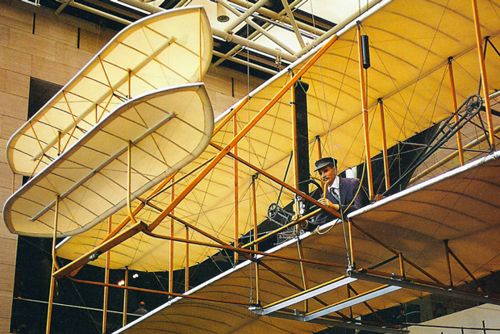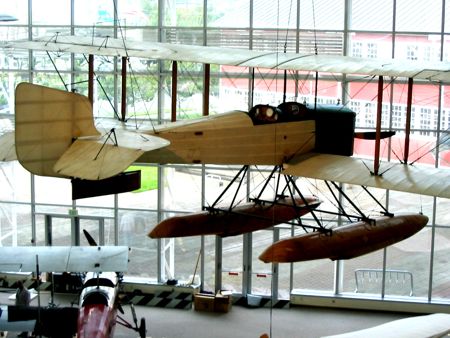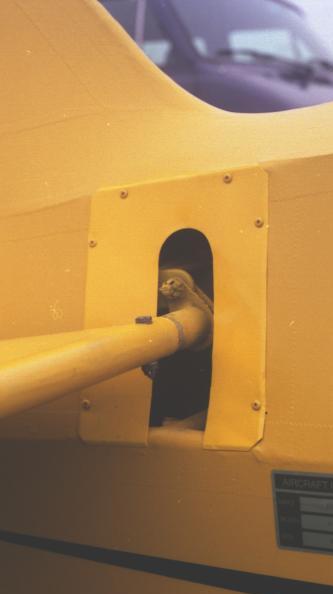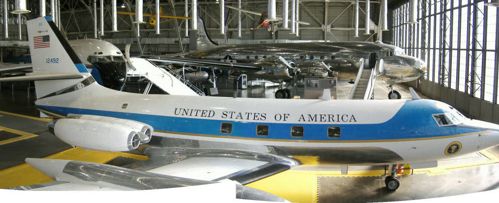Stabilizers

The brilliant Wright Bros of course are at the root of much of
this. Besides “inventing" the airplane, they were - of
necessity - the first S and C men - Stability and Control. During
their pioneering development work, much has been written about their
Control activities. It was generally understood that air flowing
over curved surfaces could generate lift - you could see that phenomena
at work just holding your hand out a train window. (Their wing
airfoil was derived from Otto Lilienthal's published tables of
aerodynamic lift. As a result of lift and "drift" (drag)
measurements taken with their own tethered glider, the brothers
concluded that Lilienthal's data were inaccurate. Upon returning to
Dayton, they designed and built a small wind tunnel to collect their
own data. But, that’s another story.)
The challenge was to control the machine that used that lift to fly,
and to do so in three dimensions. They recognized this challenge
- itself a breakthrough - and solved it. They could control the
airplane in flight around three axes. They eventually added a
fixed vertical stabilizer for yaw control, later making it movable
- thus becoming an all-moving rudder.
But the other part of this two-part conundrum also had to be recognized
and solved - namely Stability. Actually, they worked this problem
first, experimenting for several years (1900-1902) on their
gliders. This problem rears its ugly head because the Center of
Lift over a wing surface interacts with the machine’s Center of
Gravity. The two are rarely coincident to start with, and worse
yet, move around a lot. The Center of Lift moves fore and
aft as the speed varies, and also as the Angle of Attack changes.
As it changes, it’s relationship with the CG causes a pitching moment
trying to pitch the nose up or down. Without some means of
stabilizing the machine, those moments will quickly cause the airplane
to tumble out of the sky - controls or no controls.
Movement of the CG was not so much a problem in those days, but
certainly was as airplanes grew in size, with airplanes like the
Concorde even pumping fuel fore and aft to precisely control the CG
location.
The Wrights solved the Stability problem by inventing a horizontal
stabilizer, set longitudinally away from the wing far enough to give it
sufficient moment arm to counteract the inherent pitching caused by the
usual position of the Lift vector, most often aft of the CG.
Their stab was in the front, and initially was a fixed surface, sized
to do the job at the speeds they were flying. They incorporated
this almost from the beginning on their gliders. They made
over 1000 flights collecting data and making changes.
 Wright's Dual Stabilator
Wright's Dual Stabilator
When it came to their powered airplane, the stab became movable - in
fact, it was an all moving surface now called a Stabilator.
Stabilator might be viewed as a modern invention - but really
stabilators came first. Today they are used on many high
performance fighters, as well as a variety of other airplanes including
the Piper Cherokee series and the Lockheed Tristar jetliner. The
Wrights used a similar, all moving single-surface for their rudder -
actually a pair of single surfaces located aft of the propellers.
If you watch movies of the Wrights’ early flights, you can see how much
activity their stabilator exhibits - in fact, it was very sensitive,
requiring frequent and occasionally large travels. (See early flights here.)
Their craft were light and flimsy and maintaining stability in pitch
was obviously no easy task. After a few years, they moved it
further forward to increase its pitching moment power - they were
increasing the stability part of the equation and reducing the amount of control
needed on a second-by-second basis. Later pilots and those flying
recreated replicas have had extreme difficulty mastering the
technique. But, the Wrights indeed DID master use of this
control and made many flights, including many long ones, over a period
of years, using their stabilator pitch control. Just another
testament to their genius -- besides being brilliant engineers and
inventors, they were extremely skilled pilots.
Later
pioneers, guys like Glenn Curtis - and the Wrights themselves (starting
in 1911) - maybe out of necessity - broke the S&C elements
out into two structural pieces - a fixed stabilizer and a movable
control surface - both for pitch and yaw (and roll in the case of
Curtiss.) This made control much easier as the pilot was not
trying to both control and stabilize the airplane at the same time -
the stab did its job and he could concentrate on controlling the
plane. They also moved these to the rear, creating what we now
call the Tailplane (some modern airplanes retain forward stabs, called
canards.)
 Boeing B&W 1916
Boeing B&W 1916
Fixed horizontal stabilizer in the rear, with movable elevator. Note All-moving vertical stab.
An upside down wing surface with a down lift vector, the horizontal
stab counteracts the normal pitch down usually found when the Lift
vector is aft of the CG. Its size could be varied by changing its
distance from the wing Lift vector, thereby giving designers a lot of
new flexibility.
After a while, as airplanes grew in
size and speed, and flew longer in cruise, pilots got tired of
constantly holding pressure on the stick to maintain straight and level
flight. Trim tabs were added to move the elevator a bit and ease
the stick forces. Initially, these were ground adjustable only,
and set, through trial-and-error, to be effective at a certain desired
speed and flight condition. Later, they became in-flight
adjustable. As airplanes got faster, these deflected elevators
adversely affected performance due to increased drag, so longitudinal
trim was moved from trim tabs on the elevators to a movable
stabilizer. A small movement of the stab equaled a large movement
of the elevator, so the stab could be adjusted and the elevators
returned to their in-trail faired position, reducing drag.
Usually, the aft end of the stab was hinged and the front moved up and
down by a control mechanism - usually a jackscrew. This
schema has been in use for a long time, and inspection of a Piper J-3
Cub stab trim reveals very little difference from that found on a
Boeing 707 or later jet transports.

Stab Trim on a Piper J-3........and a Boeing 737
Not all trim systems use this scheme, however. Kelly Johnson, at some point decided that moving the horiz stab involved structural complexities that he preferred to avoid. In April 1947, he designed and patented an alternate scheme - - one in which the horiz stab was fixed to the vertical fin, and its AOA varied by rotating the entire fin assembly around a central pivot. This arrangement was especially attractive for horiz stabs mounted in mid fin (cruciform) or on top (T-Tail.) He immediately put that design to use on the XF-90 fighter and later on the Jetstar, which was designed and built in 1957.

Jetstar - Fixed horiz stab / pivoting vertical stab
Stab Trim Power
Jet transports brought two new wrinkles to the stab trim
equation. Swept wings usually stalled from the tip inwards and
hence moved the lift vector forward, causing a pronounced pitch-up
tendency at stall. T-Tails, as noted in my Deep Stall article,
dropped the tailplane into the wing’s turbulent wake during stall,
causing a potential complete loss of effectiveness, and hence a Deep
Stall, usually unrecoverable. Jets also brought a big increase in
the longitudinal position of the lift vector resulting from a much
greater operational speed envelope, and sophisticated leading and
trailing edge high lift devices. Their stabs were correspondingly
very large and very powerful.
One of the first buggaboos experienced on the 707 / KC-135 was a worry
about that powerful stab “running away” due to a system fault.. A
stab lockout was devised, and those familiar with the 707 / 727 / 737
know that device, which is triggered by trimming the stab and then
moving the column in the opposite direction. The stab locks out
immediately with a loud crash as the lockout cams engage.
The big trouble however turned out to be human caused. The first
major accident I recall involving the stab was the NW 720B crash in the
Everglades in 1963. The airplane was climbing out of MIA in an
area of heavy convective activity. The pilot was possibly chasing
airspeed and altitude and in a huge updraft, he applied large amounts
of down elevator to counteract, accompanied by a large amount of nose
down stab trim, when the elevator wasn’t enough. When the
airplane exited the updraft and entered a large downdraft, the airplane
was badly mistrimmed. The now opposing elevator loads can “jam"
the stab - over-powering the stab trim motors used to move the
jackscrew. (The only way out in this case, was to unload the stab
by applying nose down elevator while retrimming the stab nose up -
tough to do when you’re pointing at the ground!) An upset
occurred and the airplane broke up during the subsequent dive.
The stab was found at the nose down limit. That’s when the term
PIO - Pilot Induced Oscillation - entered the common aviation
lexicon. After a series of similar incidents and accidents in
quick succession, including DC-8 accidents to Eastern climbing out of
New Orleans and Trans-Canada climbing out of Montreal, pilot training
moved to the now familiar Pitch and Power emphasis, where the
airplane’s attitude and thrust are maintained at the expense of
airspeed and altitude - and somewhat "loose" attitiude at
that. After all these years, this topic is still front and
center and is much discussed in the Forums concerning the recent AF 447
accident involving an A330 in a heavily convective situation and
impaired Air Data inputs.
See the Autopilot Involvement